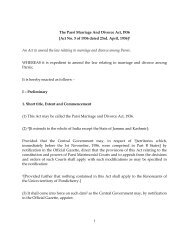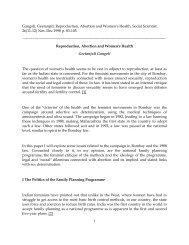The status of women, fertility and family planning among tribals of ...
The status of women, fertility and family planning among tribals of ...
The status of women, fertility and family planning among tribals of ...
You also want an ePaper? Increase the reach of your titles
YUMPU automatically turns print PDFs into web optimized ePapers that Google loves.
Sharma, Vinit; Sharma, Anuragini : <strong>The</strong> <strong>status</strong> <strong>of</strong> <strong>women</strong>, <strong>fertility</strong> <strong>and</strong> <strong>family</strong><strong>planning</strong> <strong>among</strong> <strong>tribals</strong> <strong>of</strong> South Rajasthan. <strong>The</strong> Journal <strong>of</strong> Family Welfare.December 1993. 39(4). P. 20-25.------------------------------------------------------------------------------------------------------------<strong>The</strong> Status <strong>of</strong> Women, Fertility <strong>and</strong> Family Planning <strong>among</strong> Tribals <strong>of</strong> SouthRajasthanIntroductionDr. Vinit Sharma <strong>and</strong> Ms. Anuragini Sharma<strong>The</strong> <strong>status</strong> <strong>of</strong> <strong>women</strong> in many parts <strong>of</strong> rural India is low. <strong>The</strong> situation is evenworse <strong>among</strong> tribal communities or primitive societies, which constituteapproximately 7.5 percent <strong>of</strong> the total population <strong>of</strong> the country [1]. In suchsocieties, which still lead an isolated existence, far removed from the modemway <strong>of</strong> life, a wife is primarfly regarded as an investment for production <strong>of</strong>labour <strong>and</strong> a chfidbearing housekeeper. In such societies, male dominance is arule, <strong>and</strong> preference for a male child, a traditional compulsion. Women areconsidered too inferior in <strong>status</strong> to voice their views <strong>and</strong> concerns even inmatters which have a direct bearing on their own health <strong>and</strong> well-being. Familyelders <strong>and</strong> caste leaders reign supreme in the decision-making processes <strong>and</strong>prehistoric practices <strong>and</strong> primitive rituals <strong>and</strong> customs are still very prevalent [2-5]. Consequently, such societies are typically characterised by uncontrolled<strong>fertility</strong> <strong>and</strong> very high maternal <strong>and</strong> infant mortality rates [6-7].<strong>The</strong> concept <strong>of</strong> the interrelationship between the social <strong>status</strong> <strong>of</strong> <strong>women</strong> <strong>and</strong>fertflity, though well-established by deductive reasoning, has arousedconsiderable scientific debate <strong>and</strong> controversy in the past, for the mere reasonthat research workers had not attempted to quantify the <strong>status</strong> <strong>of</strong> <strong>women</strong> innumerical terms [8-13]. Moreover, a number <strong>of</strong> vital medical parameters withsocial causes <strong>and</strong> consequences had been omitted in such computations. In thepresent study, an attempt has been made to develop a comprehensive sociomedicalscale to measure the social <strong>status</strong> <strong>of</strong> <strong>women</strong> <strong>and</strong> to study <strong>fertility</strong>behaviour <strong>and</strong> <strong>family</strong> <strong>planning</strong> practices <strong>among</strong> tribal communities.<strong>The</strong> scale was developed by taking into consideration a number <strong>of</strong> social <strong>and</strong>medical parameters such as the height <strong>and</strong> weight <strong>of</strong> adult <strong>women</strong>, theireducational <strong>status</strong>, age at marriage, number <strong>of</strong> children possessed <strong>and</strong> desired,preference for male children, nutritional deficiencies (especially prevalence <strong>of</strong>anaemia <strong>and</strong> night blindness), the utilisation <strong>of</strong> health care services such asantenatal care, <strong>family</strong> <strong>planning</strong> pracice, <strong>and</strong> so on.1
Samle <strong>and</strong> Methodology<strong>The</strong> study was conducted in the Udaipur district <strong>of</strong> Southern Rajasthan, whichhas a high concentration <strong>of</strong> <strong>tribals</strong>. Out <strong>of</strong> the 18 Community DevelopmentBlocks in the district, nine are Tribal Development Blocks, which are includedunder the tribal sub-plan. By the process <strong>of</strong> simple r<strong>and</strong>om sampling, four <strong>of</strong> theTribal Development Blocks were selected for the study. A list <strong>of</strong> the villages inthe selected tribal blocks was obtained <strong>and</strong> six villages from each <strong>of</strong> the selectedTribal Development Blocks were chosen to form the sampling frame <strong>of</strong> the study.We thus had a list <strong>of</strong> 24 villages with a high concentration <strong>of</strong> tribal population.However, we were compelled to include one more village in the study duringthe time <strong>of</strong> survey because <strong>of</strong> a request from the local leaders <strong>of</strong> that village towhom the inclsion <strong>of</strong> their village in the study was a matter <strong>of</strong> prestige.Based on the objectives <strong>of</strong> the study, all the female opinion leaders <strong>and</strong> wives <strong>of</strong>male opinion leaders from the 25 sample villages were included. For the purpose<strong>of</strong> the present study, the definition <strong>of</strong> opinion leaders proposed by Rogers [14]was adhered to, wherein opinion leaders have been defined as, "thoseindividuals ftom whom others seek information, guidance <strong>and</strong> advice", <strong>and</strong> thesociometric method <strong>of</strong> identification <strong>of</strong> opinion leaders was followed [15-16].<strong>The</strong> rationale for selecting the female opinion leaders <strong>and</strong> or the spouses <strong>of</strong> maleopinion leaders for this study was that opinion leaders represent the local elitewhose advice is <strong>of</strong>ten sought by the community. <strong>The</strong>y are a mirror <strong>of</strong> the socioculturalpractices <strong>of</strong> the community, since the general population <strong>of</strong> the areatends to follow <strong>and</strong> copy their lifestyles <strong>and</strong> patteim <strong>of</strong> social behaviour.Furthermore, a study <strong>of</strong> opinion leaders obviates the necessity <strong>of</strong> stratification <strong>of</strong>the population sample according to religious, socio-economic or culturalcharacteristics.Based on the above inclusion criteria, a total <strong>of</strong> 182 female opinionleaders/spouses <strong>of</strong> opinion leaders could be enlisted for our study. Out <strong>of</strong> these,83 (45.6 percent) had received a short-term orientation training in <strong>family</strong><strong>planning</strong> organised by the Government <strong>of</strong> India through the local primary healthcare set up. <strong>The</strong>se respondents were assigned to Group A <strong>of</strong> the study, while theremaining 99 had not received a formal training in <strong>family</strong> <strong>planning</strong> <strong>and</strong> wereincluded in Group B.Data regarding the age, socioeconomic <strong>status</strong>, educational background <strong>and</strong> otherrelevant general characteristics <strong>of</strong> the respondents were collected by means <strong>of</strong> apretested, structured interview schedules. Additionally, the social <strong>status</strong> <strong>of</strong> these<strong>women</strong> was determined by scoring on a five-point equidistant scale (AppendixI). We also calculated the bias in favour <strong>of</strong> the male child in the study groups.2
Results <strong>and</strong> Discussion<strong>The</strong> present study was carried out in 25 remote villages with a high percentage <strong>of</strong>tribal population. Most <strong>of</strong> the villages do not have proper transport facilities <strong>and</strong>the majority <strong>of</strong> them are cut <strong>of</strong>f from the rest <strong>of</strong> the world during the rainyseason. In these villages while even the bare necessities <strong>of</strong> life like food <strong>and</strong>adequate clothing are scarce, water <strong>and</strong> electricity are unaffordable luxuries. Alarge majority <strong>of</strong> the population is illiterate <strong>and</strong> poverty is rampant.Table 1 presents the socio-demographic pr<strong>of</strong>ile <strong>of</strong> the respondents.Table 1 : Socio-demographic pr<strong>of</strong>ile <strong>of</strong> respondentsParameter studies Group A Group BNumber 83 99Mean age (in years) 46.7 52.3Number <strong>of</strong> members per <strong>family</strong>12-5> 56 (7.3)8 (21.6)58 (71.1)Average <strong>family</strong> size 5.7 5.9Desired number <strong>of</strong> children23> 3Age at marriage< 14 years15-19 years> 20 yearsAge at birth <strong>of</strong> first child14-16 years17-19 years> 20 yearsAge <strong>of</strong> youngest child5 years6-10 years> 21 years20 (24.1)58 (69.9)5 (6.0)29 (34.9)47 (56.7)7 (8.4)17 (20.5)46 (55.4)20 (24.1)15 (18.1)56 (67.5)12 (14.4)Mean social <strong>status</strong> score 15.2 14.111 (11.1)26 (26.3)62 (62.6)31 (31.3)59 (59.6)9 (9.1)34 (34.3)59 (59.6)6 (6.1)22 (22.2)58 (58.6)19 (19.2)21 (21.2)47 (47.5)29 (29.3)* 2 couples had no children.Weight mean <strong>of</strong> both groups = 14.60 (social <strong>status</strong> <strong>of</strong> <strong>women</strong>). Figure in bracketsdenote percentages.It was observed that almost all (95.4 percent) the respondents were illiterate asagainst 31.3 percent <strong>of</strong> their husb<strong>and</strong>s who were also illiterate. A large majority3
<strong>of</strong> them were less than 45 cms. in height (90.3 percent) <strong>and</strong> less than 38 kg.weight (70.0 percent), thus pointing to chronic under-nutrition <strong>and</strong> inadequatecare received during their childhood <strong>and</strong> adolescent years. Moreover, more than92 percent <strong>of</strong> them were found to be suffering from moderate to severe anaemia<strong>and</strong> almost 33 percent <strong>of</strong> them showed evidence <strong>of</strong> varying degrees <strong>of</strong> vitamin Adeficiency.<strong>The</strong>se clinical manifestations reflect the current nutritional <strong>status</strong> <strong>of</strong> the <strong>women</strong>in the study, <strong>and</strong> are in accordance with the findings <strong>of</strong> earlier studies carried out<strong>among</strong> tribal populaitions [5], [17]. Malnutrition <strong>among</strong> tribal <strong>women</strong> has amultifactorial aetiology with its roots embedded deep in the tribal psyche. To the<strong>tribals</strong>, who are faced with object poverty, a young woman is more importantlyan earning member <strong>of</strong> the <strong>family</strong> <strong>and</strong> hence a vital asset. Pregnant tribal <strong>women</strong>are compulsorily underfed under the notion that overfeeding or even properfeeding <strong>of</strong> the pregnant mother will result in a healthy, large baby, <strong>and</strong> therebyto prolonged <strong>and</strong> difficult labour. Such a myth has forced the <strong>tribals</strong> tounderfeed pregnant mothers in the hope that the baby will be small <strong>and</strong> henceeasily delivered [5], [17]. Earlier studies [18] in this population, have alsoreported that a larger percentage <strong>of</strong> the girl children were suffering frommoderate to serve degrees <strong>of</strong> malnutrition (62 percent) as compared to malechildren (38 percent).Another important factor which has been documented as having a direct <strong>and</strong>significant bearing on the <strong>fertility</strong> <strong>of</strong> a couple is the age at marriage [13]. In ourstudy we found that quite a large number <strong>of</strong> the respondents (35.0 percent) hadbeen married even before attaining the age <strong>of</strong> 4 years, <strong>and</strong> not surprisingly,almost 21 percent <strong>of</strong> them had given birth to their first child when they werebetween 14-16 years <strong>of</strong> age.In rural India, a large number <strong>of</strong> girls are married <strong>of</strong>f before their 15th birthdayinspite <strong>of</strong> legislation prohibiting the marriage <strong>of</strong> girls before 18 years <strong>of</strong> age. Intribal communities, it is customary to marry children at any time during theirchildhood <strong>and</strong> some parents even indulge in anticipatory marriages, even beforethe birth <strong>of</strong> their children [5], [19].Fertility <strong>and</strong> <strong>family</strong> <strong>planning</strong>Table 1 also indicates that irrespective <strong>of</strong> their <strong>family</strong> <strong>planning</strong> training, theaverage <strong>family</strong> size was over 5 children, bemg slightly higher (5.9) <strong>among</strong>respondents who had not received such training as compared to 5.7 <strong>among</strong> thosewho had. Similarly, on the basis <strong>of</strong> the number <strong>of</strong> children desired <strong>and</strong> actuallypossessed by the respondents, were able to calculate a clear-cut bias <strong>of</strong> themagnitude <strong>of</strong> 13 times (461: 36.14) in favour <strong>of</strong> the male child (Table 2).4
Table 2 : Preference for male child expressed by the respondentsParameter studies Group A Group BNo. <strong>of</strong> living male children12> 2No. <strong>of</strong> male children desired12> 2No. <strong>of</strong> living female children12> 2No. <strong>of</strong> female childrendesired12(200)104231(209)85718(187)312923(230)84940(241)36133(213)383326Bias in favour <strong>of</strong> the male child = 461 : 036.40 (Approx. 12 times). Figures inbrackets indicate the cumulative total for the group.None <strong>of</strong> the respondents interviewed by us desired more than one female childin their families, whereas over 61 percent expressed a preference for at least twomale children <strong>and</strong> 21 percent desired more than two male children. <strong>The</strong> centuriesold concept <strong>of</strong> a male child being the cause <strong>and</strong> medium <strong>of</strong> salvation still appearsto dominate tribal thoughts <strong>and</strong> consequently, female children are mostlyneglected <strong>and</strong> underfed. In such societies the birth <strong>of</strong> a son is a matter <strong>of</strong> greatjubilation <strong>and</strong> a <strong>family</strong> is considered incomplete, <strong>and</strong> the mother a downtrodden,worthless creature without the birth <strong>of</strong> a son.Additionally, we also tried to inquire about the age <strong>of</strong> the youngest child <strong>of</strong> therespondents. Surprisingly, the youngest child <strong>of</strong> about one-fifth <strong>of</strong> therespondents was less than five years <strong>of</strong> age, thereby indicating that most <strong>of</strong> themhad themselves been actively reproductive up to the very time <strong>of</strong> menopause.Such a trend was evident in both the groups, their training in <strong>family</strong> <strong>planning</strong>notwithst<strong>and</strong>ing. Further more, barring a few exceptional cases, none <strong>of</strong> theinterviewed <strong>women</strong> had ever availed <strong>of</strong> antenatal care <strong>and</strong> most <strong>of</strong> the deliverieshad been conducted by untrained traditional birth attendants at home.Most <strong>of</strong> the respondent’s felt that they had no say, whatsoever, in decisionmaking within the <strong>family</strong>. Similarly, almost all <strong>of</strong> them said that they had notinherited anything (<strong>and</strong> were not likely to get anything) from the ancestral(80)80-(86)86-5
property <strong>of</strong> their parents. Both these factors point to a degradingly low <strong>status</strong> <strong>of</strong><strong>women</strong> in this society <strong>and</strong> it was surprising to note that even in matters like<strong>family</strong> <strong>planning</strong>, the method <strong>of</strong> contraception to be adopted by the couple,utilisation <strong>of</strong> antenatal care services, etc. which are all known to have a directeffect on the health <strong>and</strong> wellbeing <strong>of</strong> <strong>women</strong>, the <strong>women</strong> had to depend on thedecisions <strong>of</strong> their husb<strong>and</strong>s or even their mothers-in-law.<strong>The</strong> practice <strong>of</strong> <strong>family</strong> <strong>planning</strong> <strong>and</strong> the use <strong>of</strong> modern contraceptives have beenknown to be non-existent <strong>among</strong> tribal people [3], [5], [18]. In our study as well,we observed that irrespective <strong>of</strong> the training in <strong>family</strong> <strong>planning</strong> received byabout 46 percent <strong>of</strong> the respondents, they themselves or their spouses were notusing any method <strong>of</strong> contraception. This significant credibility Gap or KAP-Gap[20], [21] can only be explained by the low <strong>status</strong> <strong>of</strong> <strong>women</strong> in these societies.Tribals have been reported to depend on certain indigenous methods for <strong>family</strong>size limitation <strong>and</strong> our respondents also described a number <strong>of</strong> primitive <strong>and</strong>/orherbal-based methods <strong>of</strong> <strong>family</strong> <strong>planning</strong> with yet unproved efficacy or safety[3], [5].<strong>The</strong> study is thus an attempt to highlight the low <strong>status</strong> <strong>of</strong> <strong>women</strong> based oncomputations <strong>of</strong> a number <strong>of</strong> medico-social factors in a primitive tribalcommunity in India <strong>and</strong> reaffirms that the <strong>status</strong> <strong>of</strong> <strong>women</strong> is a very importantfactor which governs <strong>fertility</strong> <strong>and</strong> <strong>family</strong> <strong>planning</strong> attitudes <strong>and</strong> practices in acommunity. In order to make any <strong>family</strong> <strong>planning</strong> programme a success it isimperative that the <strong>status</strong> <strong>of</strong> <strong>women</strong> is improved so as to give them the power todecide their own destiny <strong>and</strong> the destinies <strong>of</strong> their families [22].References1. Census <strong>of</strong> India, 1981: Primary census abstract. Scheduled Tribes; Series 1,Part II,B, Government <strong>of</strong> India Press, Shimla (1983).2. Sharma, D.: Education <strong>and</strong> Socialisation <strong>among</strong> the Tribes,Commonwealth Publishers, New Delhi, 1988.3. Sharma, V.: "India's poor tribes stick to their traditions", Entre Nous(WHO/UNFPA), V. 19, 18 December 1991.4. Singh, J.P., Vyas, N.N. <strong>and</strong> Mean, R.S.: Tribal Women <strong>and</strong> Development,M.L.V. Tribal Research <strong>and</strong> Training Institute, Udaipur, 1985.6
5. Sharma, V. <strong>and</strong> Sharma, A.: "Health pr<strong>of</strong>ile <strong>of</strong> pregnant adolescents<strong>among</strong> selected tribal populations in Rajasthan, India", Journal <strong>of</strong>Adolescent Health, 13:696-703 (1992).6. Ramalingaswami, P.: "Tribal <strong>women</strong> <strong>and</strong> their health problems", SwasthHind, 31:148-50 (1987).7. Behura, N.K.: "Environmental changes affecting tribal <strong>women</strong>-Problems<strong>and</strong> solutions", In Pati, R.N. <strong>and</strong> Jena B. (eds.), Tribal Development inIndia, Ashish Publishing House, New Delhi, 1989.8. Jejeebhoy, Shireen J.: "Women's <strong>status</strong> <strong>and</strong> <strong>fertility</strong>-Successive crosssectionalevidence from Tamil Nadu, India 1970-80", Studies in FamilyPlanning, 22:27-33 (1991).9. Kritz, M.M. <strong>and</strong> Gurak, D.T.: "Women's <strong>status</strong> <strong>and</strong> <strong>family</strong> formation insub-saharan Africa", International Family Planning Perspectives, 15:100-105 (1989).10. Weeks, J.R.: "<strong>The</strong> demography <strong>of</strong> Islamic nations", Population Bulletin,(Population Reference Bureau, Inc. U.S.A.), 43:25 (1988).11. Population Crisis Committee: "Poor, powerless <strong>and</strong> pregnant-Countryrankings <strong>of</strong> the <strong>status</strong> <strong>of</strong> <strong>women</strong>", Population Briefing Paper No.20, 1988.12. United Nations: "Status <strong>of</strong> <strong>women</strong> <strong>and</strong> <strong>family</strong> <strong>planning</strong>", Policy Paper(C/CN-6/575/Ref. No. E/75/VS), New York, 1975.13. Jejeebhoy, Shireen J.: Women's roles-health <strong>and</strong> reproductive behaviour".In UNFPA South Asia Study <strong>and</strong> Population Policy <strong>and</strong> Programmes:India (Report), New Delhi, 1990.14. Rogers, E.M. <strong>and</strong> Shoemaker, F.F.: Communication <strong>of</strong> Innovations, FreePress, New York, 1971.15. Sinha, K.S.: "Identification <strong>of</strong> leaders in health education" Swasth Hind,24:324-26 (1986).16. Mann, C.K.: "Identification <strong>and</strong> utilisation <strong>of</strong> local leadership in <strong>family</strong><strong>planning</strong> programmes in an urban set up", Journal <strong>of</strong> Family Welfare,19:15-20 (1973).7
17. Singh, A.K., Sinha, S.K., Singh, S.N. <strong>and</strong> Jayswal, M.: "<strong>The</strong> mythy <strong>of</strong> thehealthy tribal", Social Change, 17:3-17 (1987).18. Sharma, V., Sharma, A.: "Family <strong>planning</strong> practices <strong>among</strong> <strong>tribals</strong> <strong>of</strong> SouthRajasthan, India", Journal <strong>of</strong> Research <strong>and</strong> Education in Indian Medicine,10:5 (1991).19. Bh<strong>and</strong>ari, B.: "Tribal marriages <strong>and</strong> sex relations, Himanshu, Publications,Udaipur (1989).20. West<strong>of</strong>f, C.F.: "Is the KAP--gap real?", Population <strong>and</strong> DevelopmentReview, 14:225-243 (1989).21. Bongaarts, J.: "<strong>The</strong> KAP-gap <strong>and</strong> the unmet need for contraception",Population <strong>and</strong> Development Review, 17:293-313 (1991).22. Boserup, E.: "Population, the <strong>status</strong> <strong>of</strong> <strong>women</strong> <strong>and</strong> rural development" InMc Nicoll, G. <strong>and</strong> Cain, M. (eds.), Rural development <strong>and</strong> populatonimtrtutions<strong>and</strong> policy, Population <strong>and</strong> Development Review,Supplement, 15:45-69 (1989).8
















